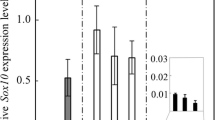Abstract
Pituitary embryonic development progresses daily toward terminal differentiation exhibiting quantitative and qualitative alterations regulated by signal molecules and transcription factors expressed under temporospatial control. In this study, we analyzed the heterogeneity of the cells in the pituitary primordium of embryonic day (E) 13.5. The three-dimensional structure of the Rathke’s pouch was built up from measurements taken from multiple DAPI-stained sections and cell populations positive to stem/progenitor marker SOX2 and pituitary-specific transcription factor PROP1 were analyzed. The pituitary primordium (Rathke’s pouch) of E13.5 showed a flattened discoid shape of about 500 μm in diameter and 200 μm depth in a dorsoventral axis and consisted in about 5,800 cells. Immunohistochemistry revealed that 0.3% of the cells in Rathke’s pouch were SOX2-negative in the lateral region, whereas all cells at E12.5 were SOX2-positive. On E13.5, the shape and size of their nuclei showed a location-specific divergence: ellipsoid morphology in the median region and round morphology in the lateral region. Moreover, on E14.5, adrenocorticotropic-hormone-positive cells (the first hormone-producing cells appearing in the pituitary) contained round nuclei. These data suggest that differentiation to pituitary-hormone-producing cells from SOX2-negative cells starts in the lateral region between E12.5 and E13.5 and that the onset of differentiation is preceded by a change in nuclear shape.




Similar content being viewed by others
Abbreviations
- ACTH:
-
Adrenocorticotropic hormone
- FITC:
-
Fluorescein isothiocyanate
- DAPI:
-
4′,6-Diamino-2-phenylindole
- PROP1:
-
Homeobox protein prophet of Pit1
- SOX2:
-
Sex determining region Y-box 2
References
Akimoto M, Nishimaki T, Arai Y, Uchinuma E, Yamauchi H, Kameda Y (2010) Hes1 regulates formations of the hypophyseal pars tuberalis and the hypothalamus. Cell Tissue Res 340:509–521
Arroyo A, Pernasetti F, Vasilyev VV, Amato P, Yen SS, Mellon PL (2002) A unique case of combined pituitary hormone deficiency caused by a PROP1 gene mutation (R120C) associated with normal height and absent puberty. Clin Endocrinol (Oxf) 57:283–291
Chen J, Gremeaux L, Fu Q, Liekens D, Van Laere S, Vankelecom H (2009) Pituitary progenitor cells tracked down by side population dissection. Stem Cells 27:1182–1195
Davis SW, Castinetti F, Carvalho LR, Ellsworth BS, Potok MA, Lyons RH, Brinkmeier ML, Raetzman LT, Carninci P, Mortensen AH, Hayashizaki Y, Arnhold IJ, Mendonca BB, Brue T, Camper SA (2010) Molecular mechanisms of pituitary organogenesis: in search of novel regulatory genes. Mol Cell Endocrinol 323:4–19
Fluck C, Deladoey J, Rutishauser K, Eble A, Marti U, Wu W, Mullis PE (1998) Phenotypic variability in familial combined pituitary hormone deficiency caused by a PROP1 gene mutation resulting in the substitution of Arg→Cys at codon 120 (R120C). J Clin Endocrinol Metab 83:3727–3734
Ikeda H, Yoshimoto T (1991) Developmental changes in proliferative activity of cells of the murine Rathke’s pouch. Cell Tissue Res 263:41–47
Kelberman D, Rizzoti K, Lovell-Badge R, Robinson IC, Dattani MT (2009) Genetic regulation of pituitary gland development in human and mouse. Endocr Rev 30:790–829
Pernasetti F, Toledo SP, Vasilyev VV, Hayashida CY, Cogan JD, Ferrari C, Lourenco DM, Mellon PL (2000) Impaired adrenocorticotropin-adrenal axis in combined pituitary hormone deficiency caused by a two-base pair deletion (301-302delAG) in the prophet of Pit-1 gene. J Clin Endocrinol Metab 85:390–397
Raetzman LT, Ross SA, Cook S, Dunwoodie SL, Camper SA, Thomas PQ (2004) Developmental regulation of Notch signaling genes in the embryonic pituitary: Prop1 deficiency affects Notch2 expression. Dev Biol 265:329–340
Sornson MW, Wu W, Dasen JS, Flynn SE, Norman DJ, O’Connell SM, Gukovsky I, Carriere C, Ryan AK, Miller AP, Zuo L, Gleiberman AS, Andersen B, Beamer WG, Rosenfeld MG (1996) Pituitary lineage determination by the Prophet of Pit-1 homeodomain factor defective in Ames dwarfism. Nature 384:327–333
Taniguchi Y, Kominami R, Yasutaka S, Kawarai Y (2000) Proliferation and differentiation of pituitary corticotrophs during the fetal and postnatal period: a quantitative immunocytochemical study. Anat Embryol (Berl) 201:229–234
Vankelecom H, Gremeaux L (2010) Stem cells in the pituitary gland: a burgeoning field. Gen Comp Endocrinol 166:478–488
Ward RD, Raetzman LT, Suh H, Stone BM, Nasonkin IO, Camper SA (2004) Role of PROP1 in pituitary gland growth. Mol Endocrinol 19:698–710
Wu W, Cogan JD, Pfaffle RW, Dasen JS, Frisch H, O’Connell SM, Flynn SE, Brown MR, Mullis PE, Parks JS, Phillips JA 3rd, Rosenfeld MG (1998) Mutations in PROP1 cause familial combined pituitary hormone deficiency. Nat Genet 18:147–149
Yoshida S, Kato T, Susa T, Cai L-Y, Nakayama M, Kato Y (2009) PROP1 coexists with SOX2 and induces PIT1-commitment cells. Biochem Biophys Res Commun 385:11–15
Yoshida S, Kato T, Yako H, Susa T, Cai L-Y, Osuna M, Inoue K, Kato Y (2011) Significant quantitative and qualitative transition in pituitary stem/progenitor cells occurs during the postnatal development of the rat anterior pituitary. J Neuroendocrinol 23:933–943
Zhu X, Gleiberman AS, Rosenfeld MG (2007) Molecular physiology of pituitary development: signaling and transcriptional networks. Physiol Rev 87:933–963
Acknowledgments
We are grateful to Dr. S. Tanaka of Shizuoka University for the antibody to human ACTH and to Dr. L.-Y. Cai of Nanjing Medical University for his valuable suggestions.
Author information
Authors and Affiliations
Corresponding author
Additional information
Hideji Yako and Takako Kato contributed equally to this work.
The authors have no competing interests to declare.
This research was partially supported by a Grant-in-Aid for Scientific Research (B) no. 21380184 and a Research Grant (A) to Y.K. from the Institute of Science and Technology, Meiji University.
Rights and permissions
About this article
Cite this article
Yako, H., Kato, T., Yoshida, S. et al. Three-dimensional studies of Prop1-expressing cells in the rat pituitary primordium of Rathke's pouch. Cell Tissue Res 346, 339–346 (2011). https://doi.org/10.1007/s00441-011-1273-8
Received:
Accepted:
Published:
Issue Date:
DOI: https://doi.org/10.1007/s00441-011-1273-8




